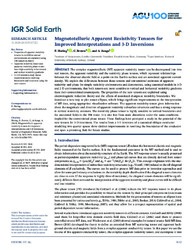Magnetotelluric Apparent Resistivity Tensors for Improved Interpretations and 3-D Inversions
DOI: https://doi.org/10.1029/2018JB017221
Persistent URL: http://resolver.sub.uni-goettingen.de/purl?gldocs-11858/9168
Persistent URL: http://resolver.sub.uni-goettingen.de/purl?gldocs-11858/9168
Hering, P.; Brown, C.; Junge, A., 2019: Magnetotelluric Apparent Resistivity Tensors for Improved Interpretations and 3-D Inversions. In: Journal of Geophysical Research: Solid Earth, Band 124, 8: 7652 - 7679, DOI: 10.1029/2018JB017221.
 |
Dokument öffnen: |
The complex magnetotelluric (MT) apparent resistivity tensor can be decomposed into two real tensors, the apparent resistivity and the resistivity phase tensors, which represent relationships between the observed electric field at a point on the Earth's surface and an associated apparent current density. We explain the differences between these tensors and conventional estimates of apparent resistivity and phase for simple resistivity environments and demonstrate, using canonical models in 1-D and 2-D environments, that both tensors are more sensitive to vertical and horizontal resistivity gradients than their conventional counterparts. The properties of the new tensors are explained using electromagnetic induction theory and the effects of associated charges at resistivity boundaries. We introduce a new way to plot tensor ellipses, which brings significant improvements to the interpretation of MT data, using appropriate visualization software. The apparent resistivity tensor gives information about the magnitude and direction of apparent resistivity subsurface structures and has a strong response to vertical resistivity contrasts. The resistivity phase tensor is highly sensitive to vertical boundaries and the associated fields in the TM mode. It is also free from static distortions under the same conditions implied for the conventional phase tensor. These findings have prompted a study in the potential of the new tensors for 3-D inversions. The results from a 3-D inversion of a canonical oblique conductor straddling two quarter spaces show distinct improvements in resolving the boundaries of the conductor and open a promising field for future studies.
Statistik:
ZugriffsstatistikSammlung:
Schlagworte:
magnetotelluricsapparent resistivity tensor
3-D inversion
forward modeling
electromagnetic field theory
This is an open access article under the terms of the Creative Commons Attribution-NonCommercial License, which permits use, distribution and reproduction in any medium, provided the original work is properly cited and is not used for commercial purposes.

